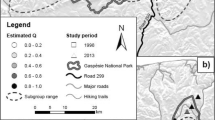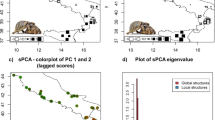Abstract
Habitat fragmentation can act to cause reproductive isolation between conspecifics and undermine species’ persistence, though most studies have reported the genetic condition of populations that have already declined to a very small size. We examined genetic diversity within the vulnerable, declining koala (Phascolarctos cinereus) population in Southeast Queensland, Australia to determine the genetic impact of ongoing threatening processes. Five hundred and twelve koalas from ten Southeast Queensland Local Government Areas on the mainland and one island were genotyped at six polymorphic microsatellite loci. Based on Bayesian cluster analysis incorporating spatial data, the regional koala population was subdivided into six clusters, with location of major roads and rivers appearing to be consistent with being barriers to gene flow. The distribution of mtDNA control region haplotypes identified distinct coastal and inland clades suggesting that historically there was gene flow between koalas along the coast (though little interchange between coastal and inland animals). In contrast, koalas from the Koala Coast (Brisbane City, Logan City and Redland Shire) were shown by microsatellite analysis to be genetically distinct from adjacent areas. It is likely, therefore, that more recent reductions in population size and restricted gene flow through urbanisation have contributed to the genetic differentiation of koalas in the Koala Coast region.







Similar content being viewed by others
References
Aguilar A, Jessup DA, Estes J, Garza JC (2008) The distribution of nuclear genetic variation and historical demography of sea otters. Anim Conserv 11:35–45
Belkhir K, Borsa P, Chikhi L, Raufaste N, Bonhomme F (2004) genetix 4.03, logiciel ous Windows pour la genetique des populations. Laboratoire Genome et Populations. Universite deMontpellier II, Montpellier
Carrick FN (1996) A review of disease in Koalas. In: Gordon G (ed) Koalas–research for management—proceedings of the Brisbane Koala symposium. World Koala Research Incorporated, Brisbane, pp 37–41
Carrick FN (2004) Koala coast protection plan. Report prepared for the premier of Queensland. The University of Queensland Koala Study Program on behalf of the Koala Conservation Council Inc., p 24
Clement M, Posada D, Crandall KA (2000) TCS: a computer program to estimate genealogies. Mol Ecol 9(10):1657–1660
Cristescu R, Cahill V, Sherwin WB, Handasyde K, Carlyon K, Whisson D, Herbert CA, Carlsson BLJ, Wilton AN, Cooper DW (2009) Inbreeding and testicular abnormalities in a bottlenecked population of koalas (Phascolarctos cinereus). Wildlife Res 36:1–10
Dique DS, Preece HJ, Thompson J, de Villiers DL (2004) Determining the distribution and abundance of a regional koala population in South-east Queensland for conservation management. Wildlife Res 31:109–117
Dixon JD, Oli MK, Wooten MC, Eason TH, McCown JW, Cunningham MW (2007) Genetic consequences of habitat fragmentation and loss: the case of the Florida black bear (Ursus americanus floridanus). Conserv Genet 8:455–464
Eldridge MDB, King JM, Loupis AK, Spencer PBS, Taylor AC, Pope LC, Hall GP (1999) Unprecedented low levels of genetic variation and inbreeding depression in an island population of the black-footed rock wallaby. Conserv Biol 13(3):531–541
Ellis WAH, Girjes AA, Carrick FN, Melzer A (1993) Chlamydial infection in koalas under relatively little alienation pressure. Aust Vet J 70:427–428
Ellis WA, Hale PT, Carrick FN (2002) Breeding dynamics of koalas in open woodlands. Wildlife Res 29:19–25
Evanno G, Regnaut S, Goudet J (2005) Detecting the number of clusters of individuals using the software strcuture: a simulation study. Mol Ecol 14:2611–2620
Fowler EV, Houlden BA, Hoeben P, Timms P (2000) Genetic diversity and gene flow among Southeastern Queensland koalas (Phascolarctos cinereus). Mol Ecol 9:155–164
Frankham R (1997) Do island populations have less genetic variation than mainland populations? Heredity 78:311–327
Frankham R, Ballou J, Briscoe D (2002) Introduction to conservation genetics. Cambridge University Press, New York, p 640
Girjes A, Hugall A, Timms P, Lavin M (1988) Two distinct forms of Chlamydia psittaci associated with disease and infertility in Phascolarctos cinereus (koala). Infect Immun 56(8):1897–1900
Goudet J (2001) FSTAT, a program to estimate and test gene diversities and fixation indices (version 2.9.3). Available from http://www.unil.ch/izea/softwares/fstat.html
Guillot G, Mortier F, Estoup A (2005) geneland: a computer package for landscape genetics. Mol Ecol 5:712–715
Hazlitt SL, Goldizen AW, Eldridge MDB (2006) Significant patterns of population genetic structure and limited gene flow in a threatened macropodid marsupial despite continuous habitat in Southeast Queensland, Australia. Conserv Genet 7:675–689
Houlden BA, England P, Sherwin WB (1996a) Paternity exclusion in koalas (Phascolarctos cinereus) using hypervariable microsatellites. JHered 87:149–152
Houlden BA, England PR, Taylor AC, Greville WD, Sherwin WB (1996b) Low genetic variability of the Koala Phascolarctos cinereus in south-eastern Australia following a severe population bottleneck. Mol Ecol 5:269–281
Houlden BA, Costello BH, Sharkey D, Fowler EV, Melzer A, Ellis W, Carrick F, Baverstock PR, Elphinstone MS (1999) Phylogeographic differentiation in the mitochondrial control region of the Koala. Mol Ecol 8:999–1011
IUCN (1987) Translocation of living organisms. http://www.iucnsscrsg.org/download/IUCNPositionStatement.pdf. Accessed on 13 Jan 2009
Lacy RC (1988) A report on population genetics in conservation. Conserv Biol 2:245–247
Lawson VJ, Carrick FN (1998) Morphology of the thyroid in coastal and non-coastal populations of the Koala (Phascolarctos cinereus) in Queensland. Gen Comp Endocr 110:295–306
Mantel N (1967) The detection of disease clustering and a generalized regression approach. Cancer Res 27:209–220
Moritz C, Geffen HE, McRae P (1997) Genetic population structure of the Greater Bilby Macrotis lagotis, a marsupial in decline. Mol Ecol 6:925–936
Nattrass AEO, Fiedler KB (1996) Koala rescue–the perception and the reality. In: Gordon G (ed) Koalas–research for management–proceedings of the Brisbane Koala symposium. World Koala Research Incorporated, Brisbane, pp 129–136
Nei M (1987) Molecular evolutionary genetics. New York, Columbia University Press
Noël S, Ouellet M, Galois P, Lapointe F (2007) Impact of urban fragmentation on the genetic structure of the eastern red-backed salamander. Conserv Genet 8:599–606
Noss RF, Copperrider AY (1994) Saving nature’s legacy. Island Press, Washington
O’Brien SJ, Evermann JF (1988) Interactive influence of infectious disease and genetic diversity in natural populations. Trends Ecol Evol 3:254–259
O’Brien SJ, Roelke ME, Marker L et al (1985) Genetic basis for species vulnerability in the Cheetah. Science 227:1428–1434
Peakall R, Smouse P (2006) GENALEX6: genetic analysis in Excel. Population genetic software for teaching and research. Mol Ecol Notes 6:288–295
Phillips B (1990) Koalas. The little Australians we’d all hate to lose. AGPS Press, Canberra
Preece H (2007) Monitoring and modelling threats to koala populations in rapidly urbanising landscapes: Koala Coast, South East Queensland, Australia. PhD Thesis. The University of Queensland
Pritchard JK, Stephens M, Donnelly P (2000) Inference of population structure from multilocus genotype data. Genetics 155:945–959
Queensland Government (2006) Nature conservation (Koala) conservation plan 2006 and management program 2006–2016. Queensland Environmental Protection Agency, Brisbane
Queensland Government (2007) Report on Koala Coast Koala surveys 2005–2006. Queensland Environmental Protection Agency, Brisbane
Queensland Government (2009) Decline of the Koala Coast Koala population: population status in 2008. Department of Environment and Resource Management, Brisbane
Raymond M, Rousset F (1995) GENEPOP (version 1.2): population genetics software for exact tests and ecumenicism. J Hered 86:248–249
Schwartz MK, McKelvey KS (2009) Why sampling scheme matters: the effect of sampling scheme on landscape genetic results. Conserv Genet 10:441–452
Segelbacher G, Hoglund J, Storch I (2003) From connectivity to isolation: genetic consequences of population fragmentation in Capercaillie across Europe. Mol Ecol 12:1773–1780
Sherwin WB, Timms P, Wilcken J, Houlden B (2000) Analysis and implications of koala genetics. Conserv Biol 14(3):639–649
Simberloff D (1994) Habitat fragmentation and extinction by birds. Ibis 137:105–111
Sloss CR, Murray-Wallace CV, Jones BJ (2006) Holocene sea-level change on the southeast coast of Australia: a review. The Holocene 17(7):999–1014
Thompson J (2006) The comparative ecology and population dynamics of koalas in the Koala Coast region of South-East Queensland. PhD Thesis. The University of Queensland
Tilman D, May RM, Lehman CL, Nowak MA (1994) Habitat destruction and extinction debt. Nature 371:65–66
van Oosterhout C, Hutchinson WF, Wills DPM, Shipley PF (2003) Micro-checker version 2.2.3 University of Hull. Available from http://www.microchecker.hull.ac.uk/. Accessed on 18 Oct 2007
Vos CC, Antonisse-De Jong AG, Goedhart PW, Smulders MJM (2001) Genetic similarity as a measure for connectivity between fragmented populations of the moor frog (Rana arvalis). Heredity 86:598–608
Weigler B, Girjes A, White N et al (1988) Aspects of the epidemiology of Chlamydia psittaci infection in a population of Koalas (Phascolarctos cinereus) in southeastern Queensland, Australia. J Wildlife Dis 24(2):282–291
Weir BS, Cockerham CC (1984) Estimating F-statistics for the analysis of population structure. Evolution 38(6):1358–1370
Acknowledgments
This project was funded by an Australian Research Council Linkage Grant, LP0455785. Thanks to Camryn Allen for providing samples from Burbank and Greg Simmons for sharing Gold Coast samples collected by Steve Phillips. David Pavlacky provided assistance with ArcGIS and Simon Blomberg assisted with performing statistical analyses. Thanks to staff of Queensland Parks and Wildlife Service Moggill Koala Hospital and Australian Wildlife Hospital for collecting samples. Thanks to Cynthia Riginos and the genetics discussion group and two anonymous reviewers for helpful feedback and suggestions.
Author information
Authors and Affiliations
Corresponding author
Rights and permissions
About this article
Cite this article
Lee, K.E., Seddon, J.M., Corley, S.W. et al. Genetic variation and structuring in the threatened koala populations of Southeast Queensland. Conserv Genet 11, 2091–2103 (2010). https://doi.org/10.1007/s10592-009-9987-9
Received:
Accepted:
Published:
Issue Date:
DOI: https://doi.org/10.1007/s10592-009-9987-9




